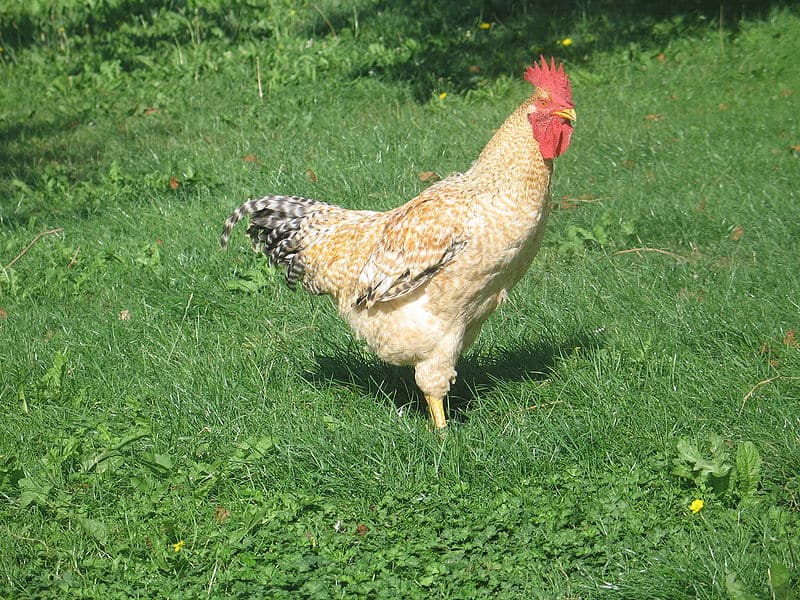If you had to choose your favorite breed of chicken, what would it be? Ask this question to a breeder familiar with Spanish chickens, and they will most likely answer Basque chickens. Indeed, this breed of chickens, still relatively unknown in North America, compensates for its rarity with its undeniable charisma! Find out everything you need to know about these big, friendly chickens without further ado.

Quick Facts About The Basque Chicken
| Breed Name: | Euskal Oiloa |
| Place of Origin: | Basque Region of France and Spain |
| Uses: | Dual purpose (eggs and meat) |
| Cock (Male) Size: | 8 pounds |
| Hen (Female) Size: | 5.5 pounds |
| Color: | Beltza (black), Gorria (red), Lepasoila (naked-necked, red-brown), Marraduna (tawny-barred), and Zilarra (silver). |
| Lifespan: | 5-10 years |
| Climate Tolerance: | Warm climates |
| Care Level: | Beginner |
| Yearly Egg Production: | 175-250 |
| Egg Size: | Large and extra-large |
| Egg Color: | Brown |
| Comb Type: | Single comb |
| Temperament: | Friendly |
| Rarity: | Very rare |
Basque Chicken Origins
The Basque hen, or Euskal Oiloa, is native to the Basque Country, in Northeastern Spain and Southwestern France. This breed originated from a selection of typical backyard chickens which began in 1975. Indeed, by the 1970s, the populations of chickens in these areas were in decline. To preserve the breed, scientists from the National Institute for Agricultural and Food Research and Technology (INIA)1 organized research work.
From 1984, a plan for the selection and genetic improvement of the breed was created at the Agronomic Research Unit of Fraisoro2 in Gipuzkoa, a province of Spain. This program ended in the early 1990s, once the four varieties3 were established (Beltza, Gorria, Zilarra, and Marraduna). The fifth variety, Leposoila, is the bald neck version of the Gorria.
Since 2008, these hens have been included in the Slow Food Foundation for Biodiversity4 as a protected breed.

Basque Chicken Characteristics
What distinguishes Basque chickens the most from other species is their temperament. Indeed, these birds are extremely friendly towards humans and easy to tame. They are also intelligent, curious, and sociable, which makes them charming chickens and highly sought after by poultry producers.
Uses
Basque hens have a dual purpose. This concept designates a type of poultry farming that can lend to a dual objective of meat and egg production, whereas in general (in the industry), the farmer is specialized in only one of these types of productions. Thus, with their impressive annual brown egg production and mouth-watering meat, the uses of Basque chickens make them very appealing for any poultry producer.
Appearance & Varieties
Basque hens exhibit the morphological characteristics of the European Atlantic chicken. It is a large bird with yellow tarsi, reddish legs with a simple and medium crest. They have red earlobes, tight plumage, and round feathers. It is a hardy and vigorous breed that is suitable for the dual use of meat and eggs. In addition, the eggs are always brown.
This breed comes in different color varieties, although the Marraduna is the most common variety. The five color varieties are the following:
- Gorria (Red)
- Marraduna (Tawny Barred)
- Beltza (Black)
- Zilarra (Silver)
- Lepasoila (Bare Neck)

Population
The data on the population of Basque hens are not sufficiently documented to know the figures on the exact population. However, a source from the Ministry of Agriculture, Fisheries, and Food of Spain mentions a population of 10,872 birds in the Basque country.
Are Basque Chickens Good for Small-Scale Farming?
Basque hens, although rare, are a good option for small-scale poultry farming. The relatively low investment and small acreage required to raise a flock of these chickens make them an ideal business for the new or part-time small farmer. The dual purpose of Basque hens makes them ideal for specialist poultry producers, as these can sell brown eggs and meat at several niche markets.
Thus, raising a flock of Basque chickens offers a great opportunity, given that producers selling their unique products to niche markets generally have good customer loyalty, limited competition, and the ability to maintain a profit margin when they have to compete with larger companies.

Conclusion
Since Basque hens are a relatively new breed and difficult to find in North America, sources of information on this dual-use breed are scarce. However, poultry producers lucky enough to raise these chickens are unanimous about their highly valuable characteristics.
See also:
Featured Image Credit: Euskal oiloa MARRADUNA barietateko OILARRA, Jose Maria Plazaola Erostarbe, Wikimedia Commons CC 3.0 Unported
